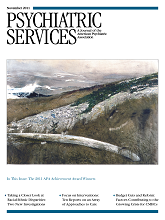Intensity of Outpatient Monitoring After Discharge and Psychiatric Rehospitalization of Veterans With Depression
Abstract
Objective:
This study assessed whether increased frequency of clinical monitoring during the high-risk period of 12 weeks after discharge from a psychiatric hospitalization reduced subsequent rehospitalization in a national cohort of Veterans Health Administration patients receiving depression treatment between 1999 and 2004.
Methods:
A case-control design was used. Patients who had at least two inpatient psychiatric hospitalizations were identified (case group, N=17,852) and then individually matched with up to two patients who also had been discharged from psychiatric inpatient settings but were not rehospitalized for the number of days between the case-group patient's discharge and subsequent rehospitalization (N=35,511).
Results:
Covariate-adjusted relative risk (RR) did not show an association between increased monitoring and subsequent psychiatric hospitalization, but there was a significant negative interaction between monitoring and a comorbid substance use disorder diagnosis (p<.001). Increased monitoring was positively associated with rehospitalization of patients without a substance use disorder, whereas increased monitoring was not associated with increased risk of rehospitalization of those with a comorbid substance use disorder. The RR of rehospitalization associated with a weekly monitoring visit (12 visits per 84 days) versus no monitoring visit was 1.14 for patients without a substance use disorder, whereas the RR was reduced to .94 for patients with a substance use disorder.
Conclusions:
Increased outpatient monitoring during the high-risk period after discharge appears to have a modest protective effect on rehospitalization among depressed patients with a comorbid substance use disorder. (Psychiatric Services 62:1346–1352, 2011)



